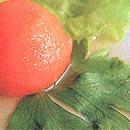Ecological Food
Defended by many and criticized by some unknowledgeable people, ecology has jumped out of the scientific boundaries onto the table.
Bored of artificially flavored products full of preserving chemicals and synthetic sweeteners, some consumers are saying “enough is enough” to these foodstuffs of ever-waning quality. This means that chemical fertilizers, pesticides, sanitary products, grow enhancers and hormones are beginning to get the ax in the realm of crops as ecological or organic items and alternative livestock breeding elbow their way in.
The matter is broached in three different angles: how to feed oneself better without hurting one's health; the environmental balance, and profitability for the farming sector.
Good News As demand for ecological products accrues, and given their shortage in the store shelves of developed countries, Latin American and Caribbean enterprises are taking the challenge and turning themselves into law-abiding organic producers.
Commercially speaking, ecological bananas –either fresh or processed- hold a potential of their own with the Dominican Republic, Mexico, Colombia, Honduras and Costa Rica as top producers. The Dominicans are also doing their own in exporting organically produced mangos, cacao, plantains and sugar.
Few people know that organic coffee embraces roughly one to two percent of the grain's world market of special coffees, a choice that's growing rapidly everywhere. Colombia, Mexico, Guatemala and Peru are some of its top exporters.
Under the wing of Colombia International, several enterprises are working in dozens of provinces nationwide to both produce and market these products.
Trends According to world's food trends, patrons everywhere are leaning to appetizers, hors d'oeuvres and desserts based on vegetables, fruits and several combinations of both.
Ecological products
-Vegetables cropped in places where technical guidelines on organic foodstuffs are applied for a period of time no less than 36 months. -Meats and eggs –either raw or processed- as long as they have been obtained in line with technical guidelines for organic products from the moment the animals were begotten. -Dairy products produced at least 12 months after the implementation of organic food guidelines. -Wild products collected in well-defined unpolluted areas and whose collection does not endanger the balance of the ecosystem.
RECIPES
If prepared with ecological products, these recipes highlight nutritional excellence.
PLANTAINS IN PEANUT SAUCE 2 plantains 1 lemon 3 garlic cloves 1/8 teaspoon of pepper ¼ cup of cooking oil 1 onion 2 teaspoons of salt 1 cup of seasoning dry wine 1 teaspoon of vinegar ½ cup of prunes ½ cup of peeled and toasted peanuts
Cut the plantains in quarts. Season them with mashed garlic, lemon juice and pepper. Put them in the fridge for a hour. Then, broil the plantains in the cooking oil with slices of onion on top. When they are broiled enough, sprinkle a pinch of salt and pour some dry wine. Lid firmly and let them cook at a simmering burn for 20 minutes. Add the peanuts –either ground or in whole grains- and the prunes. Let the whole mixture take a slow burn for 10 more minutes.
BANANAS AND ORANGES 2 big ripe bananas ¾ cup of sugar ¾ cup of orange juice 3 tablespoons of butter ½ teaspoon of salt
Peel off the bananas and cut them in longwise slices of approximately one centimeter wide each. Put the slices in the bottom of a casserole (they shouldn't be on top of one another). Sprinkle them with sugar, orange juice, butter cubes and salt. Cook them at a simmering burn and with a lid on them for roughly a hour. Serve hot.
SEASONED EGGPLANTS 1 big eggplant (or two small eggplants) 1 onion 2 peppers (one ripe and one green would be better) 4 tablespoons of vinegar 1 teaspoon of salt 1 tablespoon of sugar 2 garlic cloves 4 tablespoons of cooking oil 2 bay leaves ½ teaspoon of wild marjoram (not ground) 4 to 5 cloves, cinnamon sticks or sweet pepper grains (to replace these spices, two coriander leaves could be used) 1/8 teaspoon of ground pepper or a piece of hot chili pepper.
Broil the eggplant slightly on a grill or hot frying pan smeared in cooking oil without adding any sugar. Cut the onion in thin slices. Roast the peppers, peel them off and slice them in strips. Put all these ingredients in an earthenware or glassware pot. Place the slices of broiled eggplant in alternate layers sandwiched with onion and pepper.
Put the vinegar, salt, sugar and spices or coriander in a casserole and let them cook until they begin to steam. Remove them from the fire. Mash the garlic slightly and put it in a frying pan with cooking oil until it begins to crisp. Pour the whole thing (vinegar, spices, the garlic and the cooking oil) over the eggplant slices. Put a lid on and let them cool. Put them in the fridge or let it rest in a fresh place for at least 24 hours before serving.
GUAVA HALVES Remove those guavas that are smashed or too ripe. Peel each and every of them carefully to remove only the thin layer, and then cut them in halves. Remove the pulp and the seeds off every half using a teaspoon.
Cover the guava halves altogether in water. Add a cinnamon stick and let them cook at a simmering burn until the halves are somewhat soft. Then, pour a cup of sugar for every pound of guava and let them boil at a slow burn without any lid on them until they are completely softened and the syrup gets a little thick.
These recipes were picked from the book entitled COCINA AL MINUTO (Cooking Right Away) by Nitza Villapol






































































